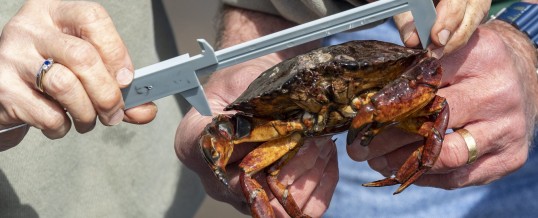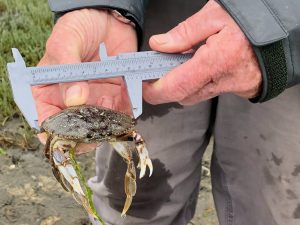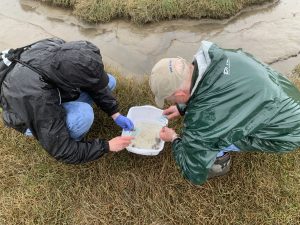
June 18, 2024
Why Measure Native Species?

A Dungeness crab resigning itself to getting measured by a monitor at Kala Lagoon (site #204). Photo credit: Wendy Feltham
When it comes to interactions between crabs, whether of the same species or of differing species, size matters. When crabs run into each other out on tide flats, in lagoons, or channels, they might compete for food or shelter, or they may actually try to prey on each other. In these encounters, the general rule of #CrabLife is that bigger crabs win over smaller crabs. So knowing the size of not only green crabs, but also the other species of crab that they are likely to encounter at a site will help us predict what the possible outcomes of crabby interactions could ultimately be.
And while some species get larger than others, all crabs start out their lives as very small larvae. So, adult Dungeness crabs or rock crabs are generally safe from adult European green crabs (which max out at about 100mm/4” or so), but other species that never grow as large as green crabs, like native shore crabs, are at risk. Here are a few size-dependent green crab interactions that have been documented:
Hairy shore crab – Hemigrapsus oregonensis (de Rivera et al. 2011 MEPS), our most abundant and charismatic native shore crabs in Crab Team traps, tops out at about half the size of green crab, and the vast majority of shore crabs we observe at Crab Team sites are under 25mm/1” across. In Bodega Harbor, California, populations of hairy shore crab declined with increases in abundance of green crab, but the good news is that populations of the native were able to recover, numerically, at times when green crab populations decreased. However, though HEOR bounced back numerically, the population was made up of crabs that were, on average, 30% smaller (10.8mm) than they were before green crabs became abundant (14.9mm), and their size recovery lagged for at least a decade after shore crab numbers rebounded. Additionally, native hairy shore crab habitat use showed a similar lag in recovery, that species moved higher up on the shore in response to green crabs, and stayed there even after green green crab populations had declined substantially.
Dungeness crab – Cancer (Metacarcinus) magister (McDonald et al. 2001) outgrow green crab as adults, but what happens when they are the same size? As very small juveniles, Dungeness crab rely on intertidal habitat that includes protective structure, like shell material. While Dungies might venture deeper once they get large enough to avoid predation, this early life period could put them in direct contact with European green crab, for which such intertidal structured habitats are prime habitat! In laboratory and field studies, researchers observed that this early life stage of Dungeness crab was out competed even by green crab of the same small size (~15mm) for both food and shelter. Further, when juvenile Dungeness crab (~15mm) were faced with juvenile green crabs (~30mm), Dungeness crabs were not only evicted into unsafe open areas, they were also directly predated by green crabs.

Two monitors at Washington Harbor (site #207) measuring native shore crabs. Photo credit: Amy Linhart
Red rock crab – Cancer productus (Hunt & Yamada 2004) is probably our toughest contender for a crab that can stand up to green crab. In laboratory trials, even when out matched by green crabs, size-wise, rock crabs were able to hold their own most of the time, and experienced very little predation from larger green crabs. By contrast, rock crabs were quite happy to incorporate green crabs of equal, or especially smaller, size into their diet. The researchers hypothesized that the competitive edge of rock crabs might lie in their claws, which are stronger for their size than those of green crabs, and that the dominance of rock crabs likely reduces the habitability of sites where they are abundant for green crabs.
Understanding which life stages of native crabs are using a site will help us predict what sites, and what species, might be most vulnerable to green crab impacts. Sites that are important nurseries for Dungeness crabs, for instance, could be prioritized for green crab removal. And the utility of data on what sites are important to sub-adult Dungeness crabs could be very important for management of the fishery. Of course, here at Crab Team we also believe that learning about native crabs for their own sake is also important!
How do we measure crabs?
So that’s a whole lot we can learn from size alone. How do we get that measurement
- Which crabs to measure: This depends on species. Because they can be so numerous in traps, we only need a subsample of measurements from native crab species. So monitoring protocols require measuring only the first 10 male and 10 female crabs, of each species, from each trap. However, because we want to develop a more robust and detailed picture of the green crab population, we measure every single green crab in the traps, regardless of sex.
- How to select crabs to measure: For the native species, when there are more than 10 of either sex in the trap, we are careful to try to select a representative subsample to measure. This is done through haphazard selection. Read more about what this means and why we do it here.
- What to measure: Crabs are measured as carapace width at the widest point of the back shell, including any spines (e.g. Dungeness crab). This is different from how many folks are used to measuring Dungeness crabs with crab gauges while fishing, which are set just in front of the rear-most spine, and use a measurement known as “notch width”. However, we chose carapace width because it can be applied consistently across all of the species of crabs we capture (well not hermit crabs, but they aren’t technically “true” crabs, but that’s for another article!). Some other groups do measure green crabs at notch width, for research purposes, but the good news is that the relationship between notch width and carapace width is very consistent across crab sizes, so if we know one, we can calculate the other with a high degree of accuracy.
-Emily Grason
JUN
2024